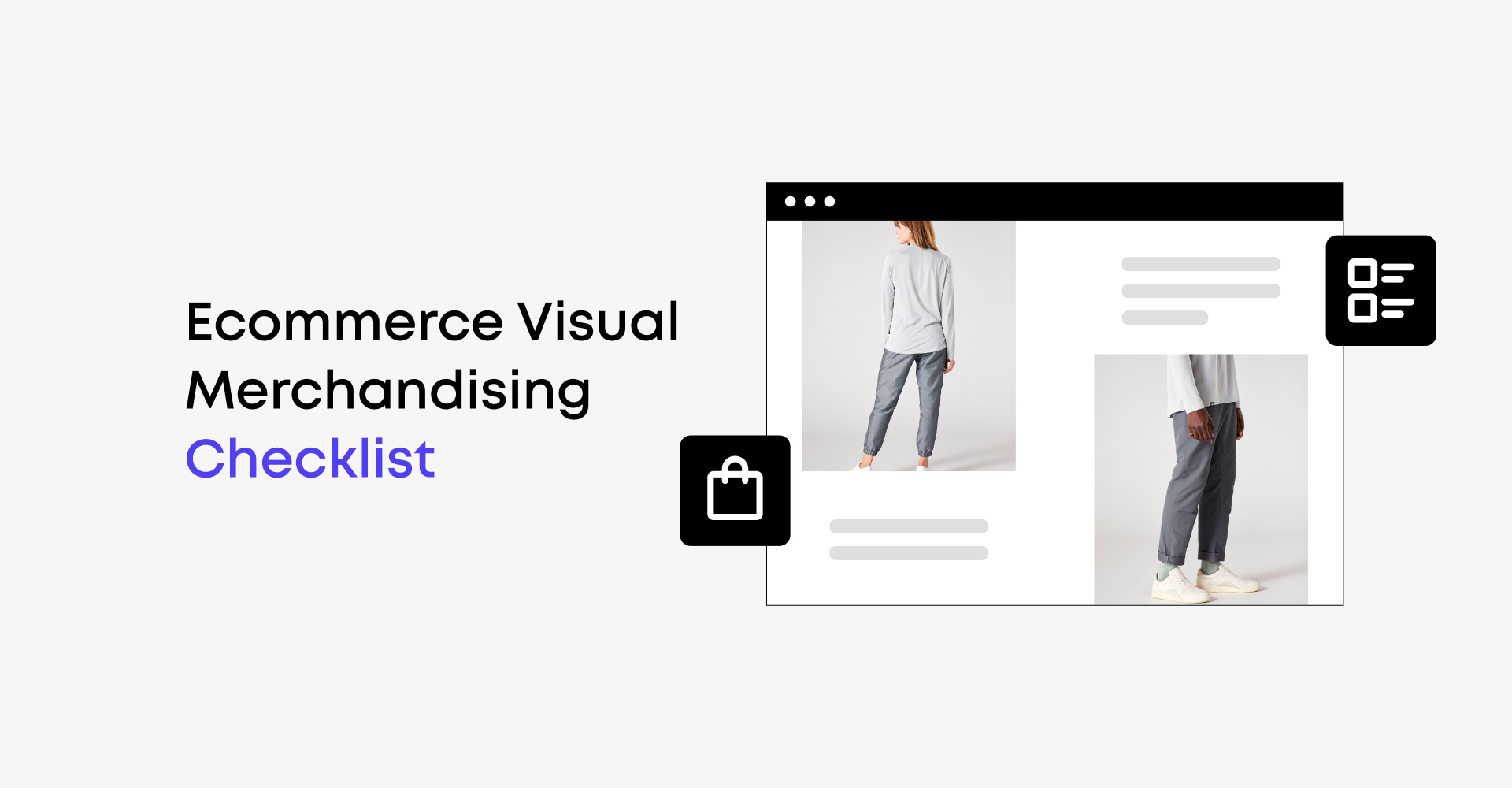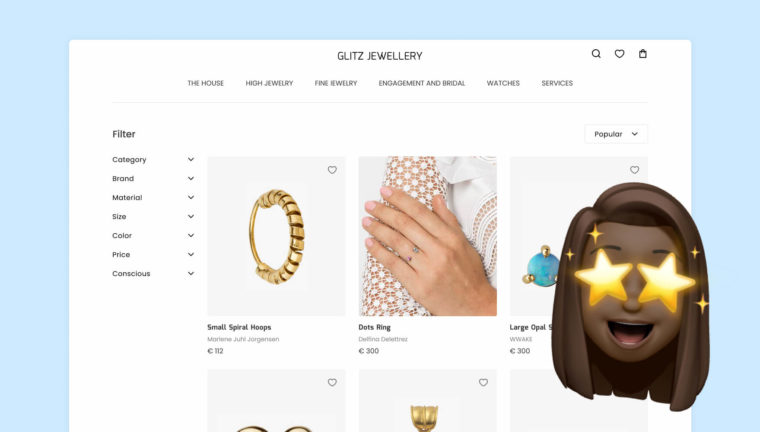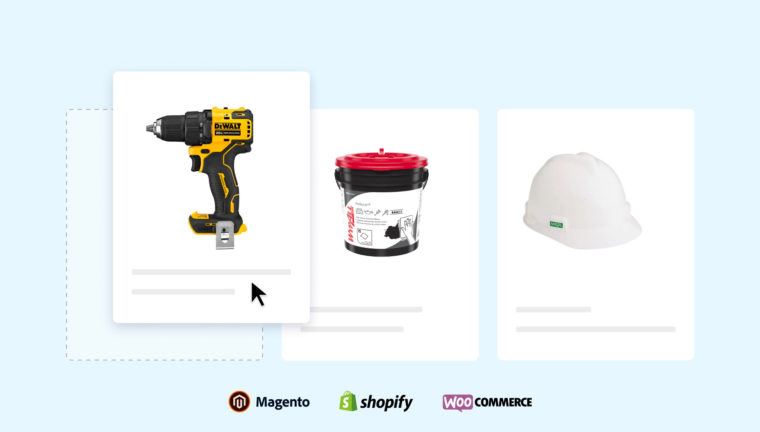When they talk about visual merchandising, typical retail shops usually come to our minds. However, in reality, this concept is essential in online sales, too, playing a crucial role in attracting customers.
And while brick-and-mortar stores rely on physical displays and window dressing, their online analogs must look for more innovative, digital ways to capture the attention of potential shoppers. In other words, you have to implement an effective eCommerce visual merchandising plan.
If you don’t know where to begin, we suggest you examine our blog piece. We’ll provide you with valuable insights that will help you improve customer experience and increase conversions, resulting in better sales.
And we’ll start, as always, with the basics, covering simple but important questions: What is eCommerce visual merchandising? How is it related to online catalog management? Is it possible to achieve maximum results with minimum effort?After reading our article, you’ll not only have all these answers but also get a ready-to-use action plan—eCommerce visual merchandising checklist. You’ll just have to introduce it in your business processes and watch customer loyalty grow along with sales.
Key Points about Ecommerce Visual Merchandising
First, we propose looking into the essence of the visual merchandising concept and clarifying its impact on customer experience in your eCommerce store. In other words, let’s answer the question, which may sound simple but has a critical value.
What Is Ecommerce Visual Merchandising?
Visual merchandising is a specific technique that focuses on creating an engaging environment to attract customers, encourage purchases, and build an immersive shopping experience. In eCommerce, it’s all about working with the components of your online store—especially its catalog—and doing so ongoingly.
To avoid confusion and achieve the desired effect, namely, high sales, you should make an eCommerce website checklist and think over your strategy step by step.
Your Successful Ecommerce Visual Merchandising Strategy
Imagine that someone asks you: How can an eCommerce launch checklist help? You’ll probably answer that such a checklist is a great option to launch an online store without missing out on something crucial. The same goes for the visual site merchandising plan. Having it prepared, you can approach the matter wisely.
To get it done, take care of the three main elements.
Efficient Catalog Management
One of the prime focuses of visual merchandising in e-commerce is the right approach to product catalog management. And that’s understandable and even obvious—after all, customers intend to go to the catalog page when they visit your online store. So, it must be efficiently organized and structured.
The topic is too complex and cannot be covered in short, so we’ll discuss it separately in due course.
Color Schemes & Branding
Another essential aspect of successful eCommerce visual merchandising is appropriate color schemes and branding elements. Make sure the eCommerce website’s design follows your corporate style if you have one (if not, it’s time to think about your unique brand identity). Incorporating the company’s colors and logo into store pages reinforces brand recognition and fosters a sense of trust with customers, resulting in a coherent and visually appealing shopping experience.
Carefully selected color schemes can also evoke specific emotions and enhance the overall aesthetic appeal of the website, further influencing customer perception and behavior.
Call-to-Action Buttons & Promotional Banner Ads
Call-to-action (CTA) buttons and promotional banners guide customers to the desired action and entice them to add items to their cart, proceed to checkout, or take advantage of time-limited offers, if any.
CTA buttons should be noticeable, visually appealing, and clearly communicate the actions they lead to. Similarly, strategically placed banner ads must capture shoppers’ attention and encourage them to explore recommended products or special discounts.
Our advice is to use eye-catching visuals, compelling copy, and the proper placement, thus ensuring a significant increase in conversion rates and driving sales. And if you aren’t an expert in these matters, seek eCommerce marketing services—you’ll have to invest financially at the start, but get more profit in the long run.
Now is the time to discuss the most important element of your eCommerce visual merchandising strategy—the online catalog—and determine how much effort you need to perfect it as much as possible.
Importance of Online Catalog Management
An online catalog is the virtual equivalent of a physical retail store with its well-structured storefronts and stocking shelves. Without a proper approach to catalog management, an e-commerce website may become cluttered, confusing, and overwhelming for customers, leading to high bounce rates and low conversions.
Benefits of Effective Catalog Management:
- Improved Searchability and Discoverability: Proper categorization, product attributes, and improved search optimization enable customers to navigate through the website effortlessly.
- Enhanced User Experience: Online catalog management creates a seamless and enjoyable shopping experience, increasing the chances of repeat purchases and customer loyalty.
- Consistent Branding and Aesthetics: A well-managed catalog allows e-commerce businesses to maintain consistent branding and aesthetics throughout their website.
- Increased Customer Trust: With proper catalog management, eCommerce businesses can ensure transparency and build customer trust and confidence in the brand. And when customers trust a brand, they’re more likely to make a purchase.
- Conversion Rates. All of the above results in higher conversion rates and, obviously, sales.
Online Catalog Management on Your Ecommerce Visual Merchandising Checklist
Now, let’s go through the steps to ensure your online catalog is well-organized and properly structured so that you get the benefits mentioned above.
Accurate Product Information
Accurate product information is the foundation of successful visual site merchandising. Without it, customers may feel uncertain about their purchases, decreasing trust and conversion rates.
Here are some essential aspects to consider:
- Detailed Product Descriptions: Provide comprehensive details about each product, including its features, specifications, and benefits.
- Clear and Concise Titles: Avoid vague or misleading titles that may confuse customers and negatively impact their shopping experience.
- Pricing and Availability: Clearly display the price and availability of each product. Keep information on products’ cost and availability up to date to avoid customer frustration caused by outdated pricing or out-of-stock items.
- Product Variations and Options: If your products come in different variations or options, such as colors, sizes, or materials, clearly present these choices.
- Dimensions, Sizes, and Weight: And, finally, include measurements and weight information, especially for items that require specific fitting or compatibility.
High-Quality Product Imagery
Your strategy will only work as it should if you use high-quality product imagery. After all, what is eCommerce visual merchandising without proper online store design? Images are the closest customers can get to physically experiencing a product before purchasing, so you must think this through beforehand.
Optimize your product images with these simple steps:
- Professional Product Photography: High-resolution images with proper lighting and composition can significantly enhance the visual appeal of your catalog, which is why you have to invest in professional product photography.
- Multiple Angles and Views: Showcase each item from various angles and views. Thus, customers have a chance to examine the product thoroughly and gain a better understanding of its appearance.
- Zoom and Enlarge Features: This feature allows shoppers to scrutinize the product details, textures, and finishes.
- Lifestyle Images and Contextual Use: Incorporate images that depict the product being used in real-life scenarios. This helps customers visualize how the product can fit into their daily activities and enhances their emotional connection to it.
Smart Product Categorization & Navigation
The next item on your eCommerce visual merchandising checklist is product categorization and navigation, which includes the following:
- Logical Categories: Categorize your products in an intuitive way and break them into logical groups, providing users with a seamless browsing experience.
- Subcategories and Filtering Options: With these options, customers can narrow down their search based on specific attributes, such as size, color, or price range.
- Breadcrumbs and Search Functionality: Breadcrumbs show the customer’s current location within the website hierarchy, while a search bar enables them to find products quickly and efficiently.
- Cross-Selling and Related Products: Take advantage of cross-selling opportunities by showcasing related products or suggesting complementary items. With such an approach, you increase average order value and encourage customers to explore more products.
Consistent Branding & Aesthetics
We’ve already mentioned the role of a consistent branding approach, but let’s be more clear about that, as successful eCommerce visual merchandising is impossible without a well-honed corporate identity:
- Coherent Color Palette: Use colors that align with your brand identity and evoke the desired emotions in your target audience.
- Consistent Typography and Fonts: Choose a set of fonts that fits your brand’s personality and consistently use them throughout your website. Thus, you ensure a uniform and professional look.
- Brand Logo and Visual Identity: Place your logo prominently on every page to reinforce brand recognition.
- Customizable Themes and Design: Tailor the design that reflects your brand’s personality and stands out from competitors.
Regular Inventory Updates and Maintenance
And, of course, you need to work correctly with your inventory:
- Out-of-Stock and Back-in-Stock Notifications: Keep customers informed about product availability. This helps manage their expectations and reduces frustration.
- Discontinued and Replacement Products: Update your catalog regularly to remove discontinued products and add new replacements.
- Seasonal and Trending Products: Stay ahead of the market by featuring seasonal and trending products prominently.
- Pricing Changes and Promotions: Keep pricing information up to date and promptly reflect any changes or promotions.
By following these simple tips, you can effectively implement visual site merchandising strategies. The only challenge is that this kind of work requires constant attention and takes a lot of time and effort. Fortunately, there are ways to simplify and speed it up.
V. Advanced Online Merchandising Tools
Modern e-commerce merchandising software automates many business processes. A good example is Sortler, a sophisticated and reliable catalog management solution.
What is Sortler?
Sortler is a great online merchandising tool for those who want to manage their product catalog intuitively and efficiently without spending much time and effort. Sortler will deal with all the catalog-related tasks itself, and you can focus on other business goals while watching the growth of conversions.
After registration, you get access to a cloud-based system, accessible anywhere at any time, and can start working with the virtual catalog. Make any changes to it and synchronize the data with your online store after approval.
Sortler’s Features:
- Smart Rules. Create online catalog management rules and assign them to Sorter. Get things done automatically without your participation.
- Drag & Drop feature. Move the catalog items around the screen manually, immediately seeing the result of your efforts.
- Scores. Assign scores to products in your range. Items with higher scores will be more visible in the catalog.
Sortler will help you complete many items on the eCommerce visual merchandising checklist. Among other things, you can do the following with this tool:
- Specify what percentage of products of each brand and category to place on the catalog page to show the full diversity of your assortment.
- Create cross-selling offers by placing matching product combinations next to each other—say, earrings and a ring from the same collection. Besides, you can control the number of such combinations on the page so as not to overdo it.
- Manage product inventory by automatically moving out-of-stock options down the catalog and highlighting items that need to be sold faster.
- Drive sales of underperforming products by moving them to the top, thus making them more visible to the customer. You can also specify the conditions under which Sortler will assign a specific discount to these positions.
But the list above reveals only a part of Sortler features, and if you’re interested to learn more, click here.
Conclusion
Following the checklist we shared, you’ll create a visually appealing and user-friendly online shopping experience that attracts buyers, drives conversions, and increases customer satisfaction.
So carefully study the insights we gave you and implement eCommerce visual merchandising best practices in your strategy. That’s all you need to do for a successful start.
Have some thoughts you want to discuss? Feel free to start a conversation with our team.






